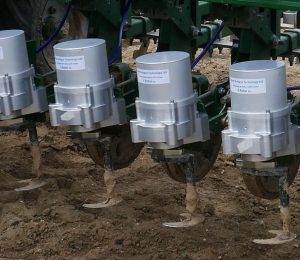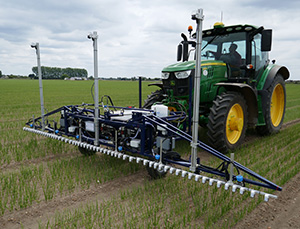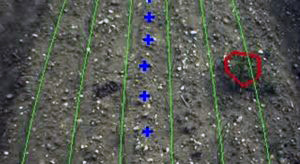TECHNOLOGY
IMAGE ANALYSIS AND CONTROL
Our vision guidance system analyses data from digital cameras to identify features of interest e.g. crop rows, individual crop plants, or weeds. We view as large an area as convenient in order maximise the data on which guidance is based.
We use a green/red ratio from colour cameras to pick out green crop and weed from backgrounds containing soil, stones and trash. (Systems to work in crops of other colours are also available.)
Crop plants are located within a scene by matching a template corresponding to the known planting pattern with crop plants as they appear in the camera image. That image is displayed live on the console with crop plants overlaid with graphics depicting the quality of the match between crop and template. Where weeds are being detected a graphic showing their perimeter is overlaid.
Features are tracked over successive images and their position can be used to guide an implement relative to those features. This may be as simple as moving an inter-row cultivator laterally to maintain alignment between rows. Alternatively, it might require the synchronisation of a rotary cultivator with individual plants as they pass under the implement. Our spot spraying technology also tracks weeds so that they can be treated individually.
Live video displayed in the console working screen allows user to check for a good match between template and actual crop geometry, which is important for good performance.
Accommodating a wide variety of implement and crop geometries whilst retaining a simple and easy to operate user interface is challenging. We reconcile that conflict using a system of configuration files that store the parameters relating to that specific machine and the crop in which it is operating. The operator has only to select the file relating to the crop they are operating on.
MECHANICAL WEEDING

The cultivation technology used in mechanical weeding is generally a well-established one with a wide variety of tools designed to cope with a range of local requirements. Our guidance techniques can be used to accurately position this range of tools to maximum their overall efficacy.
Only when introducing novel techniques such as our in-row weeding have we had to design our own special cultivation blades.
SPOT SPRAY TECHNOLOGY

Conventional agricultural spraying aims to distribute droplets as evenly as possible over an entire field. Conversely spot spraying requires droplets to be targeted within several very small well-defined areas within a field. This high-resolution spraying requires nozzles with narrow clearly delineated footprints that can rapidly form and collapse a spray pattern.
One has the choice of either moving nozzles independently so that one nozzle can cover a width wider than its footprint or, fitting numerous fixed nozzles such that their footprints together cover the full width of the implement in the manner of an inkjet printer. The former has work rate limitations and so we have chosen to work with a linear array of closely spaced nozzles.
As suitable nozzles are not commercially available, we have been forced to develop our own, which we now sell alongside our control systems.


